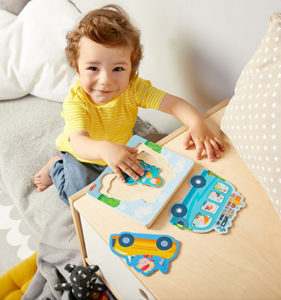Peace of Mind for Parents – Fun, Easy Ways to Play with Math at Home
Published on Wednesday, September 30th, 2020
- Sing songs and chant! Many songs, chants, and verses have patterns. Learning a song’s pattern helps children remember the song. Patterns repeat in a predictable way that helps children know what comes next. Songs and chants, like “Five Green and Speckled Frogs,” “Five Little Monkeys,” “Hokey Pokey,” and “Ten Little Fingers,” teach number order—children count up or down from a number. They also teach spatial words, like on, in, out, and around.
- Read picture books. Visit your local library and check out great picture books about counting, numbers, patterns, measurement, shapes, and engineering. For ideas, take a look at the book lists atym.edc.org/math-books/published-books and earlymath.erikson.edu/series/book-ideas.
- Use your fingers. When children count on their fingers, they are strengthening their number knowledge and their ability to visualize numbers in their minds. You and your child can play these two games with fingers, toys, and other objects—or even people!
- How Many Do You See? Have your child count your fingers and see how many different ways you can “show 5” on two hands. Then, you can show numbers up to 10. Eventually, add your child’s hands and go up to 20.
- How Many Are Hiding? Start with your whole hand and “hide” some fingers. Ask children, “How many fingers are hiding?”
- Do puzzles. Playing with puzzles helps children to think about spatial
 relationships, identify shapes, look for patterns, and find solutions. Start with easy jigsaw puzzles and add more challenging ones when your child is ready. You can even make your own puzzles by drawing a picture and cutting it into two, three, four, or more pieces!
relationships, identify shapes, look for patterns, and find solutions. Start with easy jigsaw puzzles and add more challenging ones when your child is ready. You can even make your own puzzles by drawing a picture and cutting it into two, three, four, or more pieces! - Build together. Building with materials like blocks, cardboard boxes, Legos, K’nex, Magna-Tiles, or Lincoln Logs helps children develop strong spatial skills.
- Try origami. The creations children make by folding paper help them develop strong spatial skills as well as logical and sequential thinking. In addition to being art, origami can be found in packaging all around us—pizza boxes, paper bags, envelopes, and take-out containers. Folding (and unfolding) paper helps children think in two and three dimensions and see how the sequence of steps affects the final design.
- Play board games. While playing games like Candy Land, Chutes and Ladders, HiHo Cherry-O, and Sorry, children move a game piece one space at a time while counting the number of spaces (an important math skill). Your child will practice recognizing the numbers of dots showing on the die without counting them. She’ll also develop perseverance, engage in problem-solving, and learn from mistakes.
- Play card games. Games like Memory, Go Fish, War, Slap Jack, Crazy Eights, Uno, and Sleeping Queens give children practice in recognizing and comparing numbers. They also help children learn to pay attention to things like shape, number, and color.
Parent Tips
- Mistakes are OK! Making mistakes is a part of learning new things. When your child makes a mistake, ask questions like, “What happened?,” “What would you do differently next time?,” to help him see it, and talk about what he can learn from the experience.
- Children tend to mimic parents’ attitudes about math. As you play these games, have fun! If you are having fun, they will too! Working through a challenge is also what makes games enjoyable. It’s no fun to play a game that’s too easy. If things get tough, you can remind children that sometimes math makes us think hard, but that challenges are good for our brains.
This information has been adapted from Games for Young Mathematicians, a program of research in early mathematics at the Education Development Center (EDC), supported by funding from the National Science Foundation and Heising-Simons Foundation. For more math information and games, visit ym.edc.org.
For more information on our S.T.E.A.M. program click here!
By JESSICA MERCER YOUNG, KRISTEN E. REED